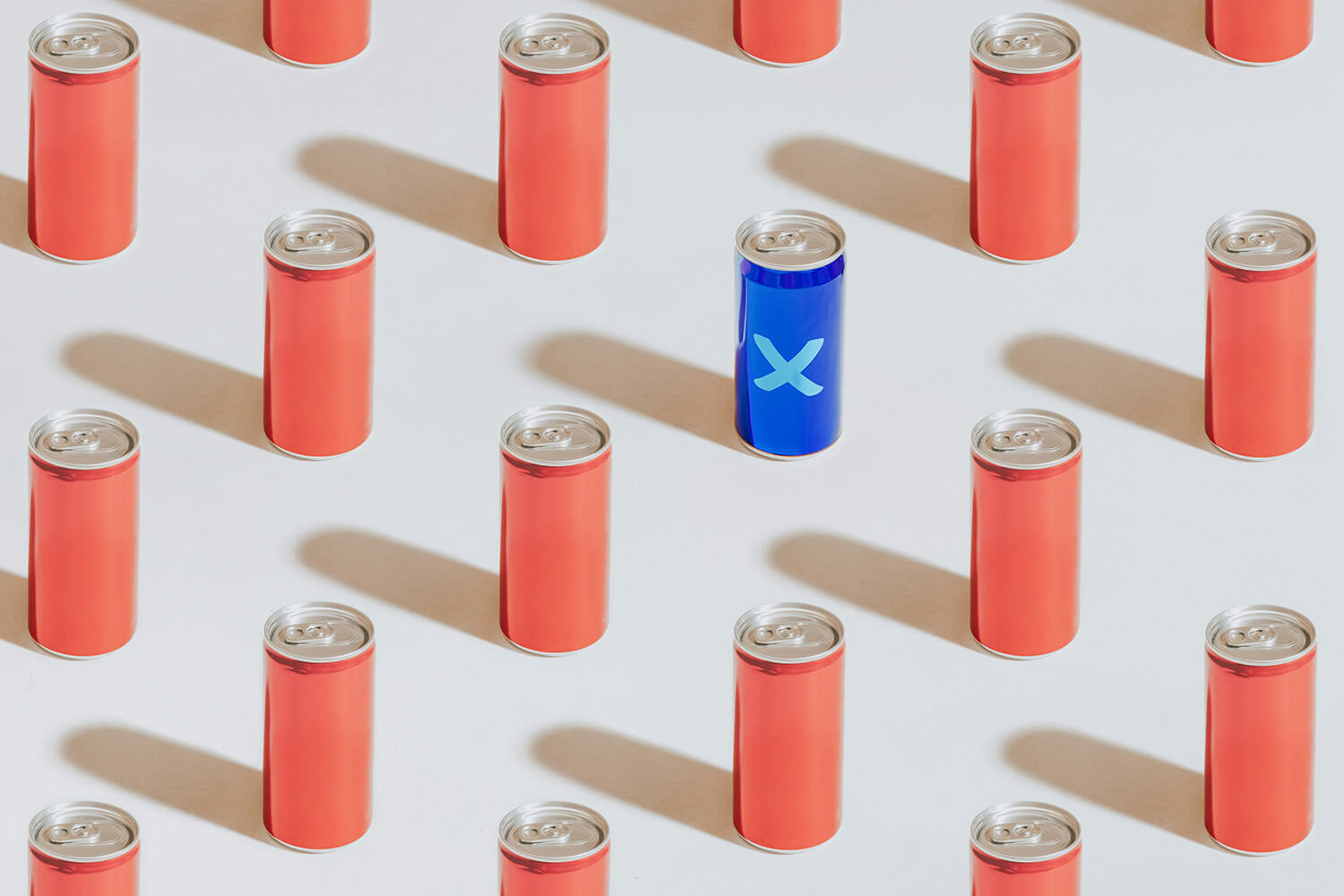The rule holds true: when the economy wavers, private label thrives. But as consumers reach more and more for cost-effective store brands, it’s feeling less like a downgrade. So where will national brands find their edge now?
Today, one in five CPG products is private label. In a world where 65% of shoppers express “extreme concern” with rising grocery prices and, among those uncomfortable with their finances, 83% call groceries their primary concern, it only makes sense that private label is now the darling of the aisles.
But the growth of private label isn’t exactly a new story: from 2019 to 2023, the rise has been steady, expanding market share from 17.7% to 19% and rising from $176 billion in sales value to over $236 billion, says Statista. Private label’s performance has long been strongest in food + beverage, reaching new heights in 2023 with $152 billion in sales—up from $107 billion just four years prior. But the numbers vary greatly from category to category too, soaring in spaces like case-ready meat but still finding their footing in aisles like snacking.
Major retailers are investing big in the opportunity, seeing private label as a strategy to drive consumer loyalty in times of ever-increasing competition and challenging supply chains. Among the most notable is Walmart, whose recent debut of bettergoods marks its “largest private brand food launch in 20 years,” featuring 300+ items across pillars like “made without” and “culinary experiences” with decidedly modern design.
“These brands aren’t only winning on price, but on value, too.”
“Retailers have realized that investing in good design leads to far more consumer interest,” says Carina Sandoval, Strategy Director at LPK. “Target has known this for decades, and now we see Walmart, Kroger and others following suit.”
Tracing Private Label’s Rapid Rise
Private label’s present-day trajectory traces back to early pandemic shifts. In 2020, private label saw a monumental surge due to a mix of pandemic factors: over 40% of consumers trialed new private- label options, whether it was due to name-brand shortages or Covid-related budget concerns. If these buying behaviors would stick was unknown at the time, but as 2024 sets new records for private-label growth, consumers, especially younger cohorts like Gen Z, continue to choose the store brand option for countless products—not just toilet paper and olive oil—even as consumers overall regain purchasing power.
“We can’t discount that Gen Z is the most frugal generation we’ve perhaps ever seen,” says Valerie
Jacobs, Chief Marketing Officer at LPK. “They came of age in tumultuous economic times and
are debt-averse. They spend less. For them, private label isn’t just an acceptable choice, it’s the
choice.”
The Gen-Z mindset is spreading more broadly, too, with many consumers displaying a “newfound frugality” to show they’re fed up with current conditions, even if the media tells them things are improving (behold the term “vibecession”). Jacobs says: “Choosing private label is one way to express frustration with an economy that’s taking too long to recover.”
The effect is broadening store-name brands’ reach across categories: “Retailers are flooding every category with private-label brands, not just food + bev or paper commodity aisles as it’s been in the past,” says David Volker, VP of Creative Excellence at LPK. From haircare to skincare, homewares to OTC, no space is off limits when it comes to private label, as evidenced by retailers like Target, CVS and Amazon, who have relied heavily on the strategy to win consumer hearts.
“You have to give a really compelling reason to be chosen, and do it in a split-second.”
Elevating Consumer Perceptions with Design
What’s especially notable—and different this time around—is how elevated private-label offerings have become, showing up on shelf with heightened designs and trend-driven aesthetics that blur the lines between private-label and premium. “Today’s consumer prioritizes emotional well-being as much as physical, and our highly visual culture has trained us to appreciate a beautiful thing,” explains Sandoval. “Appealing packaging design is now an integral part of our daily dopamine diet.”
The sharper focus on creative strategy is enhancing overall consumer perceptions, converting short-term choices into long-term loyalty. “These brands aren’t only winning on price, but on value, too,” Volker explains. “Price is temporal, but value is long-term and achieved through thoughtful brand-building. Private labels are now acting like the big players with deep consumer research, trend reports, ESG-centric messaging and sophisticated marketing programs. In short, they are starting to offer the intrinsic value that once belonged only to the big national brands.”
Protecting Your Brand in “Dupe Culture”
In certain circles, a private-label offering is becoming synonymous with the term “dupe”—essentially a more affordable version of a coveted name-brand product. Dupe culture’s roots are in beauty and fashion, largely on Instagram and TikTok, but the consumer phenomenon is spreading beyond those categories, sparking a generally higher level of comfort with cost-effective, aesthetically-on-point alternatives.
“It’s hard to even discern which one is the ‘store brand’ now.”
The plot twist is how dupe culture has normalized private-label preference, opening the gates for these store brands to not show up as “knockoffs,” but with equities all their own: “The long-held approach for private-label brands was to mimic the name-brand competitor as closely as possible,” explains Jacobs. “But now, modern private labels are wielding design and tone of voice to show up strong, premium and differentiated. It’s hard to even discern which one is the ‘store brand’ now.” It’s also fair to say that store brands can move quicker to keep pace with trends, seeing their brand equity as less precious and likely more malleable.
In a landscape where two products both look good and both offer a benefit, consumers are choosing the one that costs less—a retail reckoning for national brands everywhere. “The challenge for big brands in this context is to demonstrate the value—financial, functional, and emotional—of their products with a strong visual presence that appeals to consumer sensibilities,” Sandoval says. “You have to give a really compelling reason to be chosen, and do it in a split-second.”
“Store brands can move quicker to keep pace with trends, seeing their brand equity as less precious and likely more malleable.”
How Name Brands Can Gain Back Edge
So what can name brands do to combat the private-label players? Recent headlines show major CPG players implementing more targeted consumer strategies to “help flip the value narrative and regain loyalty,” says Consumer Goods.
Volker recommends focusing on innovation to draft your roadmap: “If you want to get in someone’s cart, answer their wants and needs in a new and unique way. National brands obviously have the robust R+D departments to do that. Pair good R+D with design thinking and suddenly, you’re on the precipice of a new golden era in product innovation.”
The persistence of private label across categories reminds brands everywhere of the power of design, too: “You can’t deny that the creative strategy matters. We tell our clients that fully baked, consistent design systems are the best way to drive top-of-mind memorability and stickiness. At LPK, we call this Shelf Persuasion.”
Lastly, as brand leader, use your consumer strategy to fend off commoditization. “Understand and align with their lifestyle, then pursue marketing tactics that private label can’t easily exploit,” Volker recommends, be it brand collaborations, LTOs, endorsements or other Retailer Exclusivity Strategies that generate timely buzz. “That’s what transforms you from yet another choice to a brand that’s shaping culture.”
LPK IS THE LEADING CREATIVE CONSULTANCY.
Through deep discovery and beautiful expression, we help businesses know, grow and innovate for their ever-changing consumers and customers—driving future brand growth and cultural relevance.








